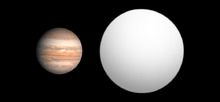 Size comparison of TrES-4 with Jupiter | |
| Discovery | |
|---|---|
| Discovered by | Mandushev et al.[1] |
| Discovery date | 2006-2007 |
Detection method | Transit |
| Orbital characteristics | |
Semi-major axis | 0.05091 ± 0.00071 AU (7,616,000 ± 106,000 km)[2] |
| Eccentricity | 0 |
| 3.553945 ± 0.000075 d | |
| Inclination | 82.86 ± 0.33[2] |
| Semi-amplitude | 86.1 |
| Star | GSC 02620-00648 A[2] |
| Physical characteristics | |
Mean radius | 1.799 ± 0.063[2] RJ |
| Mass | 0.919 ± 0.073[2] MJ |
| 7.04 ± 1.12 m/s2 (23.1 ± 3.7 ft/s2) 0.718 ± 0.114 g | |
| Temperature | 1782 ± 29[2] |
TrES-4b is an extrasolar planet, and one of the largest exoplanets ever found, after WASP-12b, WASP-17b, CT Chamaeleontis b (though the latter may be a brown dwarf) and GQ Lupi b. It was discovered in 2006, and announced in 2007, by the Trans-Atlantic Exoplanet Survey, using the transit method. It is approximately 1,400 light-years (430 pc) away orbiting the star GSC 02620-00648, in the constellation Hercules.[1]
Orbit
A 2008 study concluded that the GSC 06200-00648 system (among others) is a binary star system allowing even more accurate determination of stellar and planetary parameters.[2]
TrES-4 orbits its primary star every 3.543 days and eclipses it when viewed from Earth.
The study in 2012, utilizing a Rossiter–McLaughlin effect, have determined the planetary orbit is probably aligned with the equatorial plane of the star, misalignment equal to 6.3±4.7°.[3]
Physical characteristics
The planet is slightly less massive as Jupiter (0.919 ± 0.073 MJ) but its diameter is about 80% larger; it was considered the largest planet ever found at the time, giving it an average density of only about 1/3 gram per cubic centimetre, approximately the same as Saturn's moon Methone. This made TrES-4 both the largest known planet and the planet with the lowest known density at the time of its discovery.[2][1]
TrES-4's orbital radius is 0.05091 AU, giving it a predicted surface temperature of about 1782 K. This by itself is not enough to explain the planet's low density, however. It is not currently known why TrES-4 is so large. The probable causes are the proximity to a parent star that is 3–4 times more luminous than the Sun as well as the internal heat within the planet.[2][1]
See also
- List of exoplanet extremes
- WASP-17b, another large exoplanet
References
- ^ a b c d Mandushev, Georgi; et al. (2007). "TrES-4: A Transiting Hot Jupiter of Very Low Density". The Astrophysical Journal Letters. 667: L195–L198. arXiv:0708.0834. Bibcode:2007ApJ...667L.195M. doi:10.1086/522115.
- ^ a b c d e f g h i Daemgen, S.; Hormuth, F.; Brandner, W.; Bergfors, C.; Janson, M.; Hippler, S.; Henning, T. (2009). "Binarity of transit host stars - Implications for planetary parameters" (PDF). Astronomy and Astrophysics. 498: 567–574. arXiv:0902.2179. Bibcode:2009A&A...498..567D. doi:10.1051/0004-6361/200810988.
- ^ Obliquities of Hot Jupiter host stars: Evidence for tidal interactions and primordial misalignments, 2012, arXiv:1206.6105
External links
![]() Media related to TrES-4 at Wikimedia Commons
Media related to TrES-4 at Wikimedia Commons
- "Team finds largest exoplanet yet". BBC News. 7 August 2007.
- "New monster planet 'could float on water'". ABC News (Australia). 7 August 2007.
- Than, Ker (August 6, 2007). "Largest Known Exoplanet Discovered". Space.com news service. Retrieved 2007-08-07.
- Muir, Hazel (August 6, 2007). "Largest known exoplanet puzzles astronomers". NewScientist.com news service. Retrieved 2007-08-07.